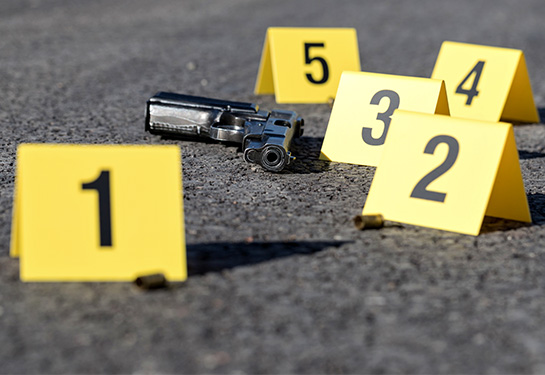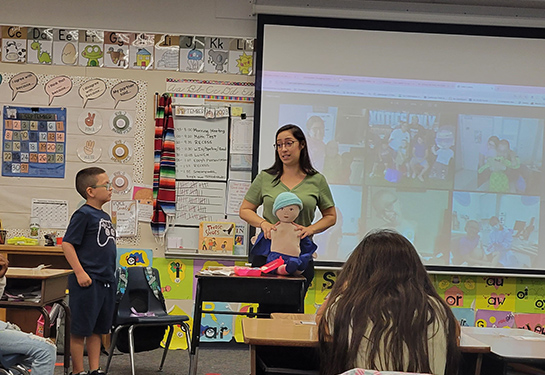How firearms move from legal purchase to criminal use
New study of California gun data identifies risk factors for weapons used in crimes
Between 1996 and 2021, more than 5.2 million handguns and almost 2.9 million long guns were legally purchased in California. During 11 years of that time frame, 2010-2021, California law enforcement officers recovered 45,247 of these guns from crime scenes.
Why were some of those guns later involved in a crime, but most not? Were there characteristics or commonalities with crime guns? Researchers at the UC Davis Violence Prevention Research Program (VPRP) wanted to know.
Their findings are published in a new study in Injury Epidemiology.
“Tracking the movement of firearms from legal purchase to use in crimes can help inform prevention of firearm injuries and deaths,” explained Hannah S. Laqueur, senior author of the study. Laqueur is an associate professor in the UC Davis Health Department of Emergency Medicine.
One key finding in the study is that guns reported lost are three times more likely to be used in a crime, and stolen guns are almost nine times more likely to be used in a crime.
“Theft is an important source of crime guns, whether as the proximal source to the criminal possessor or simply as an important source of firearms entering the illicit market,” Laqueur said.
Research methods
The team built on similar research conducted 20 years ago that was now considered dated. They analyzed gun recovery data with millions of gun sale records that California dealers are required to report to the state. They looked at characteristics of the transactions, the firearms, dealerships and gun purchaser’s demographic characteristics, purchasing history, criminal history and neighborhood socioeconomic status.
The data revealed numerous characteristics associated with an increased risk that a purchased gun would end up recovered in a crime (see the full data table here.)

Gun characteristics associated with weapons being recovered at a crime include:
- Lost and stolen
- Cheap (made by a low-cost manufacturer)
- Semiautomatic
- Large and medium caliber (compared to small caliber)
Buyer characteristics associated with guns being recovered at a crime include:
- First-time purchasers
- Younger, female, Black, Hispanic, Native American or Pacific Islander or other race/ethnicity (versus white)
- People who bought more than 12 guns in a year
- A history of arrests during the past 10 years (gun crime, intoxication, major property crime and major violent crime)
- Those who lived in a more socially vulnerable census tract
Dealer characteristics associated with guns being recovered at a crime include:
- Average sales per year
- Percentage of transactions that were administrative denials
- Percentage of sales that were pawns or pawn redemptions in the previous calendar year
- Percentage of sales in the past calendar year that became crime guns in the next calendar year
Identifying upstream factors associated with firearm recovery in crimes can inform violence prevention efforts, making communities safer.” —Sonia L. Robinson, research data analyst, UC Davis Violence Prevention Research Program
The study noted some similarities to what researchers had discovered earlier.
“We were able to identify that associations found 20 years ago are still relevant today — cheap, semiautomatic, and larger caliber handguns are more likely to be recovered in crimes,” said Sonia L. Robinson, first author of the study. Robinson is an epidemiologist and a research data analyst at VPRP. “We found that several additional factors were associated with firearm recovery — specifically, the purchaser having a previous criminal history and a firearm being reported lost or stolen.”
The researchers also identified factors that decreased the likelihood of a gun ending up in a crime. These include:
- Dealers with more than 20% of their gun sales to police in the past calendar year
- Guns that had any previous law enforcement holds
- Guns transferred between family members
The researchers note that the study’s strength is the size and thoroughness of the database, with more than 8 million firearm transactions from 1996 to 2021, plus information on each transaction type, dealer, and purchaser, including their prior criminal history and records of purchase. A limitation is that the study only examines legal purchases reported on the state’s database for gun transactions, known as the Dealer’s Record of Sale.
They also note that since a firearm reported lost or stolen is strongly associated with its recovery in a crime, measures to secure firearms from theft or loss should be a primary focus for the prevention of firearm-related crimes moving forward.
“Identifying upstream factors associated with firearm recovery in crimes can inform violence prevention efforts, making communities safer,” Robinson said.
Additional authors include Christopher D. McCort, Colette Smirniotis and Garen J. Wintemute from VPRP.
Funders
This research was funded by the National Collaborative on Gun Violence Research (NCGVR).
Resources
The UC Davis Violence Prevention Research Program (VPRP) is a multi-disciplinary program of research and policy development focused on the causes, consequences and prevention of violence. Studies assess firearm violence, the social conditions that underlie violence, and the connections between violence, substance abuse and mental illness. VPRP is home to the University of California Firearm Violence Research Center, which launched in 2017 with a $5 million appropriation from the state of California to conduct leading-edge research on firearm violence and its prevention. For more information, visit health.ucdavis.edu/vprp/.






